Do you have a question about the Yamaha WR250F 2016 and is the answer not in the manual?
Locates and describes important warning and information labels on the vehicle.
Provides essential guidelines for handling electrical components and basic service procedures.
Lists and illustrates specialized tools required for accurate adjustment and assembly.
Explains the operation of various controls and indicators on the vehicle's handlebar and dashboard.
Details procedures for starting the engine, including cold and warm starts, and essential break-in steps.
Provides guidelines for cleaning, maintaining, and storing the motorcycle to preserve its condition and performance.
Lists detailed technical specifications for the engine, including dimensions, fluids, and components.
Outlines detailed technical specifications for the chassis, including frame, wheels, brakes, and suspension.
Provides detailed specifications for the vehicle's electrical system components, including voltage and resistance.
Specifies correct tightening torques for various fasteners to ensure proper assembly and prevent damage.
Presents a schedule for regular checks and maintenance jobs required for optimal vehicle operation and longevity.
Details essential pre-ride checks to ensure the motorcycle is in good operating condition before use.
Covers procedures for checking and adjusting engine-related components, including coolant and oil levels.
Describes checks and adjustments for chassis components such as brakes, wheels, steering, and suspension.
Explains how to adjust chassis components like tire pressure, front fork, and rear suspension for optimal performance.
Covers the removal, checking, disassembly, assembly, and installation of the front wheel.
Details the procedures for removing, checking, disassembling, assembling, and installing the rear wheel.
Explains the removal, disassembly, checking, assembly, and installation of the front brake system components.
Covers the removal, disassembly, checking, assembly, and installation of the rear brake system components.
Details the removal, disassembly, checking, assembly, and installation of the front fork legs and their components.
Explains how to handle, remove, check, and install the rear shock absorber assembly and its related parts.
Provides instructions for removing the engine from the chassis, including related components like exhaust and electronic parts.
Covers removal, checking, and installation procedures for the camshaft, timing chain, and related components.
Details the removal, checking, and installation of the cylinder, piston, piston rings, and related components.
Explains the removal, checking, assembly, and installation of the clutch and its components.
Covers the removal, checking, and installation of the transmission, shift drum, and shift forks.
Provides instructions for removing, handling, and checking the radiator and its related parts.
Details the removal, checking, installation, and assembly of the water pump and its components.
Covers the removal, checking, and installation procedures for the fuel tank, fuel pump, and fuel sender.
Explains the removal, checking, and adjustment of the throttle body and its associated sensors.
Explains the circuit diagram and troubleshooting steps for the ignition system.
Details the circuit diagram and troubleshooting procedures for the electric starting system.
Provides the circuit diagram and troubleshooting steps for the charging system, including battery checks.
Covers the circuit diagram and troubleshooting for the lighting system, including bulb and fuse checks.
Explains the circuit diagram, ECU self-diagnosis, and troubleshooting for the fuel injection system.
Identifies and illustrates various electrical components used in the motorcycle's system.
Lists common causes and checks for engine starting failures, covering engine, fuel, and electrical systems.
Details potential causes for poor brake performance, including issues with pads, discs, fluid, and hoses.
Provides a table of diagnostic codes, their corresponding items, and troubleshooting procedures for the fuel injection system.
Locates and describes important warning and information labels on the vehicle.
Provides essential guidelines for handling electrical components and basic service procedures.
Lists and illustrates specialized tools required for accurate adjustment and assembly.
Explains the operation of various controls and indicators on the vehicle's handlebar and dashboard.
Details procedures for starting the engine, including cold and warm starts, and essential break-in steps.
Provides guidelines for cleaning, maintaining, and storing the motorcycle to preserve its condition and performance.
Lists detailed technical specifications for the engine, including dimensions, fluids, and components.
Outlines detailed technical specifications for the chassis, including frame, wheels, brakes, and suspension.
Provides detailed specifications for the vehicle's electrical system components, including voltage and resistance.
Specifies correct tightening torques for various fasteners to ensure proper assembly and prevent damage.
Presents a schedule for regular checks and maintenance jobs required for optimal vehicle operation and longevity.
Details essential pre-ride checks to ensure the motorcycle is in good operating condition before use.
Covers procedures for checking and adjusting engine-related components, including coolant and oil levels.
Describes checks and adjustments for chassis components such as brakes, wheels, steering, and suspension.
Explains how to adjust chassis components like tire pressure, front fork, and rear suspension for optimal performance.
Covers the removal, checking, disassembly, assembly, and installation of the front wheel.
Details the procedures for removing, checking, disassembling, assembling, and installing the rear wheel.
Explains the removal, disassembly, checking, assembly, and installation of the front brake system components.
Covers the removal, disassembly, checking, assembly, and installation of the rear brake system components.
Details the removal, disassembly, checking, assembly, and installation of the front fork legs and their components.
Explains how to handle, remove, check, and install the rear shock absorber assembly and its related parts.
Provides instructions for removing the engine from the chassis, including related components like exhaust and electronic parts.
Covers removal, checking, and installation procedures for the camshaft, timing chain, and related components.
Details the removal, checking, and installation of the cylinder, piston, piston rings, and related components.
Explains the removal, checking, assembly, and installation of the clutch and its components.
Covers the removal, checking, and installation of the transmission, shift drum, and shift forks.
Provides instructions for removing, handling, and checking the radiator and its related parts.
Details the removal, checking, installation, and assembly of the water pump and its components.
Covers the removal, checking, and installation procedures for the fuel tank, fuel pump, and fuel sender.
Explains the removal, checking, and adjustment of the throttle body and its associated sensors.
Explains the circuit diagram and troubleshooting steps for the ignition system.
Details the circuit diagram and troubleshooting procedures for the electric starting system.
Provides the circuit diagram and troubleshooting steps for the charging system, including battery checks.
Covers the circuit diagram and troubleshooting for the lighting system, including bulb and fuse checks.
Explains the circuit diagram, ECU self-diagnosis, and troubleshooting for the fuel injection system.
Identifies and illustrates various electrical components used in the motorcycle's system.
Lists common causes and checks for engine starting failures, covering engine, fuel, and electrical systems.
Details potential causes for poor brake performance, including issues with pads, discs, fluid, and hoses.
Provides a table of diagnostic codes, their corresponding items, and troubleshooting procedures for the fuel injection system.
| Engine Type | Liquid-cooled, 4-stroke, DOHC, 4-valve |
|---|---|
| Displacement | 250cc |
| Bore x Stroke | 77.0mm x 53.6mm |
| Compression Ratio | 13.5:1 |
| Fuel System | Fuel Injection |
| Ignition | TCI: Transistor Controlled Ignition |
| Final Drive | Chain |
| Rear Suspension | KYB® single shock; fully adjustable |
| Front Brake | Hydraulic single disc brake, 250mm |
| Rear Brake | Hydraulic single disc brake, 245mm |
| Front Tire | 80/100-21 |
| Rear Tire | 110/100-18 |
| Transmission | Constant mesh, 6-speed |
| Front Suspension | Inverted fork |
| Width | 32.5 inches |
| Wheelbase | 58.3 in |
| Fuel Capacity | 2.0 gallons |
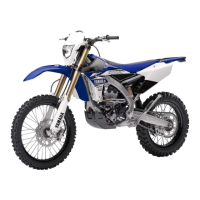
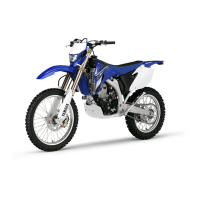
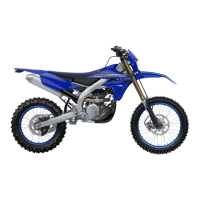
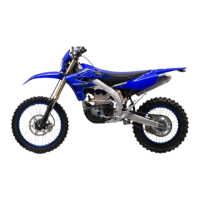

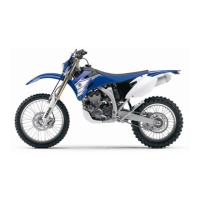




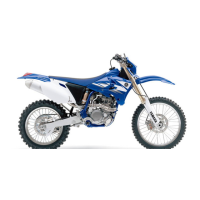
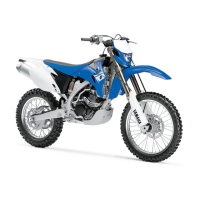
